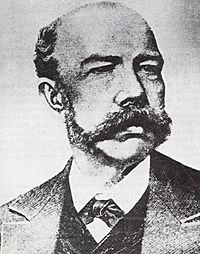Manuel Saumell facts for kids
Manuel Saumell Robredo (born April 19, 1818 – died August 14, 1870) was a famous Cuban composer. He is known for creating new types of music that mixed different cultures, especially Cuban traditions. Because of this, many people say he was the first to start Cuban national music. He is as important to Cuban music as Mikhail Glinka was to Russian music around the same time.
Contents
Manuel Saumell's Early Life
Manuel Saumell was born in Havana, Cuba. His family did not have much money. He studied piano with Juan Fédérico Edelmann. He also learned about harmony, arranging, counterpoint, and fugue from Mauricio Pyke. Pyke was the director of an Italian opera company that visited Havana.
Saumell was a very busy musician. He played the organ in church and performed music by Beethoven. He also organized musical meetings, created orchestrations and arrangements, and taught music classes. People described Saumell as a hard worker. He was sensitive and generous to others. He always wanted to achieve great things in music.
An Opera Project
When he was 21, Saumell was inspired by a singer named Dolores de Saint-Maxent. She had introduced the music of Schubert to Cuba. Dolores came from a wealthy family. They did not approve of her marrying Saumell.
Even so, Saumell planned to write a nationalistic opera to show off her talent. The opera was based on a novel called Antonelli. The story took place in Havana in 1590. It included black slaves working at a sugar mill. The engineer Antonelli falls in love with a beautiful Siboney quadroon. But she was already promised to the nephew of the Governor of Havana.
Sadly, Dolores ended their relationship before the opera's story could be written. Saumell stopped working on the project. He went back to writing contradanzas and earning a living from his music. However, his opera idea was very important. He had planned for native people and black slaves to sing and be part of the story. This was something new and special in the Americas at that time.
Saumell's Musical Works
Saumell wrote more than fifty contradanzas. These were popular dances, usually in 2/4 or 6/8 time. His music was full of new rhythms and melodies. It is said that no two pieces were alike; he always created something new.
Contradanzas usually had two parts. The first part, called a prima, had eight or sixteen bars. The second part, called a segunda, had sixteen bars. Saumell often wrote the prima in a classical style. Then, he would write the segunda in a Cuban folk style. This mix of styles made his music unique.
Influence on Cuban Music
Saumell's music was very forward-thinking. He created rhythms that would later become important in other Cuban music styles. Many people consider him the "father" of the contradanza. But his influence went even further.
His music contained elements that would later be found in the habanera, danzón, guajira, and criolla. Experts say that everything done in Cuban music after him built upon his ideas. His work deeply influenced the history of Cuban national music.
The scores of Saumell's Contradanzas for piano are available at Cuatro 40 Ediciones in printed form or as downloadable PDF files.
See also
 In Spanish: Manuel Saumell Robredo para niños
In Spanish: Manuel Saumell Robredo para niños


